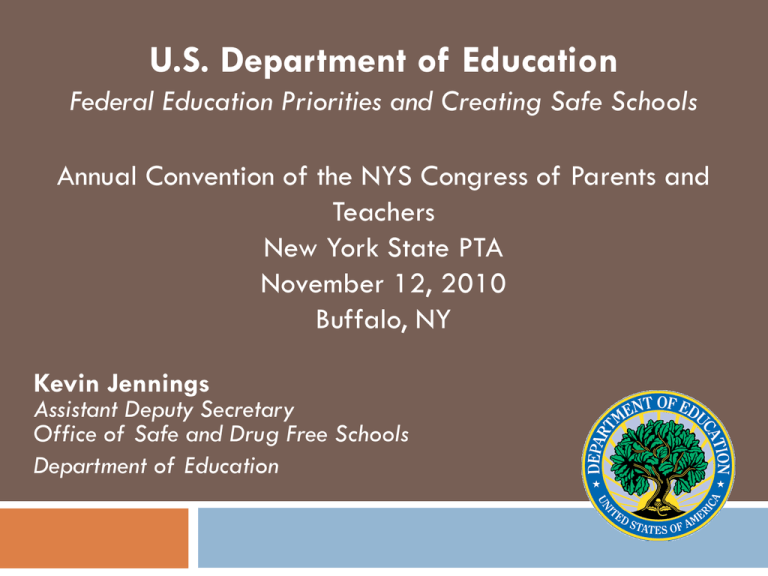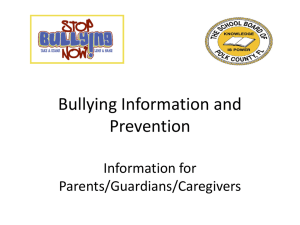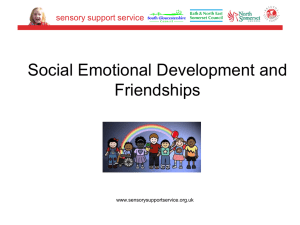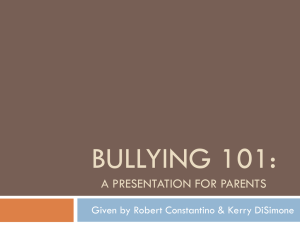
U.S. Department of Education
Federal Education Priorities and Creating Safe Schools
Annual Convention of the NYS Congress of Parents and
Teachers
New York State PTA
November 12, 2010
Buffalo, NY
Kevin Jennings
Assistant Deputy Secretary
Office of Safe and Drug Free Schools
Department of Education
What’s the goal at ED?
President Obama:
“Produce a higher
percentage of college
graduates than any other
country in the world by the
end of the next decade.”
Sources: The College Board, Education Pays 2010, Figure 1.1; U.S. Census Bureau, 2009; Internal
Revenue Service, 2008; Davis et al., 2009; calculations by the authors
More Education, Longer Life
Source: National Longitudinal Mortality Study, 1988-1998
The US is Falling Behind in HS Graduation Rates
Approximate percentage of persons with high school or equivalent qualifications in the age group 25-64
13
1
1
27
1. Year of reference 2004.
2. Including some ISCED 3C short programs
3. Year of reference 2003.
Source: Organization for Economic Cooperation and Development (OECD), Education
at a Glance 2008
High School Graduation Rates among
OECD nations, 2007
Note: 1995 graduation rates are calculated on a gross basis whereas 2007 are calculated as net graduation rates (for countries with available
data).
1. Year of reference 2006.
Countries are ranked in descending order of the upper secondary graduation rates in 2007.
Source: Education at a Glance 2009: OECD Indicators. Table A2.2. (www.oecd.org/edu/eag2009).
U.S. : Higher Ed Leader in the Sixties, the Laggard Today
Percent of Adults with an Associate Degree or Higher by Age Group - U.S. & Leading OECD Countries
Source: OECD, Education at a Glance 2008
New York Lags the Nation in Graduation Rates
Averaged Freshman Graduation Rate, School Year 2007-2008
U.S. Department of Education, National Center for Education Statistics, Common Core of Data. "NCES Common Core of Data State Dropout and
Completion Data File." School Year 2007–08, Version 1b. Retrieved at http://nces.ed.gov/pubs2010/graduates/tables/table_01.asp
New York Achievement Gap
Averaged Freshman Graduation Rate, by race/ethnicity: 2007 -2008
90
80
70
60
50
40
30
20
10
0
Asian/Pacific
Islander
White
American
Indian/Alaska
Native
Black
Hispanic
National Center for Education Statistics. (2010). Public School Graduates and Dropouts From the Common Core of Data: School Year 20072008. NCES 2010-341.
Where does the Office of
Safe & Drug Free Schools fit in?
It’s simple.
Students can’t learn if they don’t feel safe.
Period.
Success? It’s a Basic Equation
(Safe Schools)(Healthy Students)=Academic Success
In a Truly Safe School
Every Student Feels Like…
They Belong.
They are Valued.
They Feel Physically and Emotionally Safe.
Substance Use
New York Students are Drinkers
% of students who currently drink alcohol
50
45
40
35
30
25
20
15
10
5
0
Louisiana- #1 in the country
New York- #11 in the
country
Utah- #42 in the country
Center for Disease Control and Prevention. (4 June 2010). Youth Risk Behavior Surveillance- United States 2009. Surveillance Summaries,
MMWR 2010;59 (No. SS-5)
New York Students Engage in High Risk Drinking
% of students who binge drink
35
30
25
20
15
10
5
0
North Dakota- #1 in the
country
New York- #22 in the
country
Utah- #41 in the country
Center for Disease Control and Prevention. (4 June 2010). Youth Risk Behavior Surveillance- United States 2009. Surveillance Summaries,
MMWR 2010;59 (No. SS-5)
New York Students Use Marijuana
% of students who currently use marijuana
30
25
20
15
10
5
0
New Mexico- #1 in the
country
New York- #17 in the
country
Utah- #42 in the country
Center for Disease Control and Prevention. (4 June 2010). Youth Risk Behavior Surveillance- United States 2009. Surveillance Summaries,
MMWR 2010;59 (No. SS-5)
Physical Safety
New York Students are Afraid to go to School
Percentage of high school students who did not go to school because they felt unsafe at
school or on their way to or from school
12
10
8
6
4
2
0
Arkansas-#1 in the country
New York- #18 in the
country
South Dakota- #41 in the
country
Center for Disease Control and Prevention. (4 June 2010). Youth Risk Behavior Surveillance- United States 2009. Surveillance Summaries,
MMWR 2010;59 (No. SS-5)
Weapons are Fairly Rare in New York Schools
% of students who carried a weapon on school property
14
12
10
8
6
4
2
0
Wyoming- #1 in the country
New York- #28 in the
country
New Jersey- #41 in the
country
Center for Disease Control and Prevention. (4 June 2010). Youth Risk Behavior Surveillance- United States 2009. Surveillance Summaries,
MMWR 2010;59 (No. SS-5)
Weapons are Fairly Rare in New York Schools
Percentage of high school students who were threatened or injured with a weapon on
school property
14
12
10
8
6
4
2
0
Arkansas- #1 in the country
New York- #23 in the
country
Pennsylvania- #39 in the
country
Center for Disease Control and Prevention. (4 June 2010). Youth Risk Behavior Surveillance- United States 2009. Surveillance Summaries,
MMWR 2010;59 (No. SS-5)
Fighting in Not Rare in New York Schools
Percentage of high school students who were in a physical fight on school property
16
14
12
10
8
6
4
2
0
New Mexico- #1 in the
country
New York- #13 in the
country
North Dakota- #41 in the
country
Center for Disease Control and Prevention. (4 June 2010). Youth Risk Behavior Surveillance- United States 2009. Surveillance Summaries,
MMWR 2010;59 (No. SS-5)
Bullying is Fairly Common in New York Schools
Percentage of High School Students who Were Bullied on School Property
30
25
20
15
10
5
0
Wyoming- #1 in the country
New York- #25 in the
country
Florida- #34 in the country
Center for Disease Control and Prevention. (4 June 2010). Youth Risk Behavior Surveillance- United States 2009. Surveillance Summaries,
MMWR 2010;59 (No. SS-5)
Who Bullies, Who Gets Bullied, Who
Enables: Understanding Roles in Bullying
Some Groups are Singled Out for Harassment
Question: “At your school, how often are students bullied, called names or harassed for the following reasons?”
Source: From Teasing to Torment: School Climate in America 2005
Rivers, I., Poteat, V.P., Noret, N., Ashurt, N. (2009). Observing Bullying at School: The Mental Health Implication of Witness
Status. School Psychology Quarterly. 24:4, 211-223.
Rivers, I., Poteat, V.P., Noret, N., Ashurt, N. (2009). Observing Bullying at School: The Mental Health Implication of Witness
Status. School Psychology Quarterly. 24:4, 211-223.
Participant Roles
Bully
Witnesses
Victim
Participant Roles
What Characterizes a Bully?
Bully
• High rates of “externalizing behavior”
- Having behaviors consistent with
ADD, ADHD, Oppositional/Defiant
Disorder, or Conduct Disorder
- Being Highly Aggressive
• Having negative perceptions of
“others”: people unlike themselves
Cook, C. R., Williams, K.R., Guerra, N.G., Kim, T.E.m & Sadek, S. (2010). Predictors of bullying and victimization in
childhood and adolescence: A meta-analytic investigation. School Psychology Quarterly, 25(2), 65-83.
Participant Roles
What Characterizes a Victim?
•Low Social Competence
-Lack basic social skills
- Unable to easily make friends
Victim
• Peer Rejection
Cook, C. R., Williams, K.R., Guerra, N.G., Kim, T.E.m & Sadek, S. (2010). Predictors of bullying and victimization in
childhood and adolescence: A meta-analytic investigation. School Psychology Quarterly, 25(2), 65-83.
Participant Roles
What Characterizes a Bully-Victim?
A bully-victim is someone who is both
the perpetrator and the target of
bullying behavior
Bully
• Bully-victims show similarly lowlevels of social competency as onlyvictims.
Victim
• Bully-victims are more easily
influenced by their peers than onlyvictims.
Cook, C. R., Williams, K.R., Guerra, N.G., Kim, T.E.m & Sadek, S. (2010). Predictors of bullying and victimization in
childhood and adolescence: A meta-analytic investigation. School Psychology Quarterly, 25(2), 65-83.
Role of Bystanders in Instances of Bullying
Witnesses
Assistants
Reinforcers
Outsiders
Defenders
Rivers, I., Poteat, V.P., Noret, N., Ashurt, N. (2009). Observing Bullying at School: The Mental Health Implication of Witness
Status. School Psychology Quarterly. 24:4, 211-223.
Why the Problem Persists…
and What We Can do
Teachers and Students Make a Difference
In classrooms where both students and teachers
had strong attitudes and actions against
bullying and aggression rates of aggression
were 1/3 to ½ of classes where peers alone
(and not teachers) had strong attitudes against
aggression
Henry, D., Guerra, N., Huessmann, R., Tolan, P., VanAcker, R., & Eron, L. (2000). Normative influences
on aggression in urban elementary school classrooms. Amerian Journal of Community Psychology,
28(1), 59-81.
Peer Intervention Works, but Isn’t Common
Of bullying episodes in which peers
intervened, 57% of the interventions were
effective (i.e., the bullying stopped within 10
seconds).
Peers intervene in only 11-19% of all bullying
incidents.
Source: Hawkins, Pepler and Craig 2001
Petrosino, A., Guckenburg, S., DeVoe, J. and Hanson, T. (2010). What characteristics of bullying, bullying victims, and schools are associated
with increased reporting of bullying to school officials? (Issues & Answers Report, REL 2010- No.092). Washington, DC: US Department of
Education, Institute of Education Sciences, National Center for Education Evaluation and Regional Assistance, Regional Education Laboratory
Northeast and Islands. Retrieved from http://ies.ed.gov/ncee/edlabs.
Petrosino, A., Guckenburg, S., DeVoe, J. and Hanson, T. (2010). What characteristics of bullying, bullying victims, and schools are associated
with increased reporting of bullying to school officials? (Issues & Answers Report, REL 2010- No.092). Washington, DC: US Department of
Education, Institute of Education Sciences, National Center for Education Evaluation and Regional Assistance, Regional Education Laboratory
Northeast and Islands. Retrieved from http://ies.ed.gov/ncee/edlabs.
Petrosino, A., Guckenburg, S., DeVoe, J. and Hanson, T. (2010). What characteristics of bullying, bullying victims, and schools are associated
with increased reporting of bullying to school officials? (Issues & Answers Report, REL 2010- No.092). Washington, DC: US Department of
Education, Institute of Education Sciences, National Center for Education Evaluation and Regional Assistance, Regional Education Laboratory
Northeast and Islands. Retrieved from http://ies.ed.gov/ncee/edlabs.
Every School Should…
Help to educate faculty, staff & parents about bullying
Have a clear policy against bullying behaviors, and communicate
this policy early and often to students, staff, and parents
Train all staff who interact with students (including bus drivers,
school resource officers, school nurses, and cafeteria workers) on
how to recognize bullying behaviors and intervene effectively to
stop them
Ensure that all staff members take immediate action when bullying
is observed.
Gather data to assess bullying, the level of staff commitment to
address bullying, and parent interest and concerns.
Every Teacher Should…
Initiate discussion with students and parents about expected behavior
before problems arise
Closely supervise your students and be watchful for possible signs of
bullying among students in your classes (sudden changes in behavior, etc)
Take immediate action if you observe or suspect bullying
Integrate bullying prevention into your curriculum in age-appropriate ways
Remember that actions sometimes speak louder than words, and be sure
that you don't inadvertently model bullying behavior
Every Student Should…
Speak up! Step in when other students are being
bullied or tell a teacher what is going on
Make it clear to others that bullying is not okay.
Support bullied students – make them feel like they
are not alone
Help teachers and administrators know what is going
on. Work with them to find solutions.
Source: HRSA Stop Bullying Now!
Every Parent Should…
Focus on their child. Be supportive and gather information about the
bullying. Don’t assume they will tell you. Believe them if they do.
Utilize resources such as HRSA’s Stop Bullying Now! Campaign and
bullyinginfo.org to become informed about bullying and bullying
prevention
Work with the staff at school to find a solution to stop the bullying, for
the sake of your child as well as other students. Get your child out of
there if you are not convinced the school will take needed action.
Source: HRSA Stop Bullying Now!
Cyber Bullying
Today’s Teens Love Technology
Percentage of teens who…
Source: The National Campaign to Prevent Teen and Unplanned Pregnancy.
Victimization
Perpetration
“Sexting” is Common
Percentage of teens sending or posting sexually suggestive messages (text, email, IM)
Source: The National Campaign to Prevent Teen and Unplanned Pregnancy.
Peer Pressure?
Percentage of teens who said pressure from a member of the opposite sex is a reason to send
sexy messages or images
Source: The National Campaign to Prevent Teen and Unplanned Pregnancy.
Vegas Syndrome
61% of teens “strongly” and
“somewhat agree” that “People my
age are more forward/aggressive
using sexy messages and
pictures/video than they are in real
life”
Source: The National Campaign to Prevent Teen and Unplanned Pregnancy.
Every Parent Should…
Talk to your kids about what they are doing in
cyberspace.
Know who your kids are communicating with.
Consider limitations on electronic
communication.
Be aware of what your teens are posting
publicly.
Set expectations.
Source: The National Campaign to Prevent Teen and Unplanned Pregnancy.
What’s the Washington Agenda?
Tie Safe Schools into Ed Reform Agenda
Build robust data systems
that track student progress
and improve practice.
Safe Schools: Measure school
safety with the same rigor we
measure academic progress
What Gets Measured is What Gets Done
Safe and Supportive Schools (s3) Model:
A New Approach to K-12 School Safety
s3 model
Engagement
Safety
Environment
Relationships
Emotional Safety
Physical
Environment
Respect for
Diversity
Physical Safety
Academic
Environment
School
Participation
Substance Use
Wellness
Disciplinary
Environment
Draft s3 Model. Please do not circulate without consent from the Office of Safe and Drug-Free Schools. Please
contact Kristen Harper (kristen.harper@ed.gov) with questions or concerns.
Winners of Safe and Supportive Schools Grants
Arizona
California
Iowa
Louisiana
Kansas
Maryland
Michigan
South Carolina
Tennessee
West Virginia
Wisconsin
Carl Joseph Walker Hoover
1998-2009
Pheobe Prince
10th Grade
South Hadley, MA
1994 – January 2010
Hope Witsell
8th Grade
Ruskin, FL
1996 – September 2009
Christian Taylor
9th Grade
Richmond, VA
1994 – May 2010
Seth Walsh
8th Grade
Tehachapi, CA
1997 – September 2010
Justin Aaberg
10th Grade
Anoka, MN
1995 – July 2010
Asher Brown
8th Grade
Harris, TX
1997 – September 2010
Carl Joseph Walker Hoover
6th Grade
Springfield, MA
1998 – April 2009
Tyler Clementi
College Freshman
Ridgewood, NJ
1992 – September 2010
Keep in Touch!
Kevin.Jennings@Ed.gov
202-245-7830






